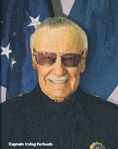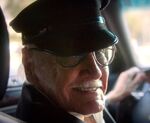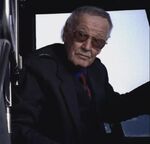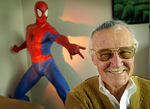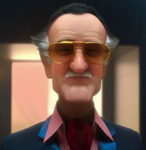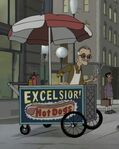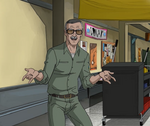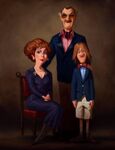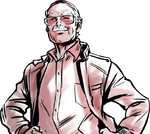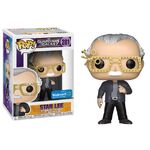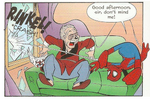This article is about the comic creator. For the documentary film, see Stan Lee (film).
Stan Lee was an American comic book writer, editor, publisher, media producer, actor, voice actor, television host, and former president and chairman of Marvel Comics. He was best known for his work in co-creating several of Marvel's first and most famous superheroes.
Stanley Martin Lieber was born on December 28, 1922, in Manhattan, New York City, in the apartment of his Romanian-born Jewish immigrant parents, Celia (née Solomon) and Jack Lieber, at the corner of West 98th Street and West End Avenue. Lee was raised in a Jewish household. In a 2002 interview, he stated when asked if he believed in God, "Well, let me put it this way... [Pauses.] No, I'm not going to try to be clever. I really don't know. I just don't know." On another interview from 2011, when asked about his Romanian origins and his relationship with the country, he said that he had never visited it and that he did not know Romanian because his parents never taught it to him.
Lee's father, trained as a dress cutter, worked only sporadically after the Great Depression. The family moved further uptown to Fort Washington Avenue, in Washington Heights, Manhattan. Lee had one younger brother named Larry Lieber. He said in 2006 that as a child he was influenced by books and movies, particularly those with Errol Flynn playing heroic roles. Reading The Scarlet Pimpernel, he called the title character "the first superhero I had read about, the first character who could be called a superhero." By the time Lee was in his teens, the family was living in an apartment at 1720 University Avenue in The Bronx. Lee described it as "a third-floor apartment facing out back". Lee and his brother shared the bedroom, while their parents slept on a foldout couch.
Lee attended DeWitt Clinton High School in the Bronx. In his youth, Lee enjoyed writing, and entertained dreams of writing the "Great American Novel" one day. He said that in his youth he worked such part-time jobs as writing obituaries for a news service and press releases for the National Tuberculosis Center; delivering sandwiches for the Jack May pharmacy to offices in Rockefeller Center; working as an office boy for a trouser manufacturer; ushering at the Rivoli Theater on Broadway; and selling subscriptions to the New York Herald Tribune newspaper. At fifteen, Lee entered a high school essay competition sponsored by the New York Herald Tribune, called "The Biggest News of the Week Contest." Lee claimed to have won the prize for three straight weeks, goading the newspaper to write him and ask him to let someone else win. The paper suggested he look into writing professionally, which Lee claimed "probably changed my life." He graduated from high school early, aged sixteen and a half,[why?][how?] in 1939 and joined the WPA Federal Theatre Project.
History[]
Lee was influenced greatly by Walt Disney; one book he saved up for when he was a young boy was The Art of Walt Disney. Eventually, Lee needed a job and his uncle, Martin Goodman (the publisher of Timely Comics), hired him on as an office assistant. Initially, Lee's job only entailed minor duties like keeping up supplies for the talent like the ink for the artists. Eventually, he got a chance to write professionally, which was an obligatory text story in Captain America Comics #2, "Captain America Thwarts the Traitor's Revenge" (in which Lee created the superhero's signature move of using his shield as a throwing weapon) and did so even during World War II when he was recruited into the U.S. Army as part of the Signal Corps.
A comic book veteran for years as Marvel Comics editor-in-chief, Lee was contemplating quitting in 1961, feeling he was wasting his life in the field, following dictates of his publisher such as when he was ordered to fire all the creative staff in the 1950s so the company could rely on unpublished archived content for a while and also endlessly following genre fads. However, his wife, Joan, suggested he indulge in writing a comic book as he would prefer first, since he was going to leave anyway. Together with artist Jack Kirby, Lee created The Fantastic Four, combining Kirby's reworked premise from his earlier series for DC Comics, The Challengers of the Unknown, with his own notions for complex character play in superhero stories.
The comic book proved unexpectedly a strong seller and with his artists like Kirby and Steve Ditko, Lee followed up with scores of new titles and characters that would make Marvel a dominant force in the medium. The writing method he used has been called "Plot-first scripting," in which Lee would create a basic plot for the artist to work on. In effect, the artist, especially Marvel's best ones such as Kirby and Ditko, functioned as co-writers creating the specific story actions, settings and characters within the boundaries of the story premise given. Once the penciling was completed, the artist would present it to Lee who would edit it as well as typically write the dialogue and captions in the story.
As editor-in-chief, Lee was also responsible for the concept of the Marvel Universe, a shared universe setting where most of the company's characters would interact with each other across the various titles. Being the official writer of most of these comic books set in this setting, Lee was able to keep aware of the various activities of the characters and coordinate events to allow them to impact stories in other titles. This enticed readers to purchase them to follow the full scope of the setting. Decades later, the media franchise, the Marvel Cinematic Universe, would adapt this narrative concept to great success in its film and television productions.
Later in his writing career, Lee was officially requested by the U.S. Federal government's Department of Health to produce a comic book story about drug abuse. Lee agreed and produced a three-part Amazing Spider-Man story in 1971 mentioning the social problem, only to find that the comic book medium censorship organization, the Comics Code Authority, refused to give their stamp of approval because the story had drug use and considered the story's context irrelevant. Lee, confident that the original government request would give him credibility and with his publisher's support, defied the Code and published without the seal. As it happened, Marvel Comics had enough market strength to ignore any reticence from the market and the story was publicly praised for addressing the social problem, while the Code's resistance was derided as counter-productive. As such, censorship organization's credibility was potentially undermined and it ultimately slid into irrelevance decades later.
Eventually, Lee was promoted to President of Marvel Comics, but found the position's duties dissatisfying and eventually moved Los Angeles to attempt to begin filmed adaptations of the company's content. This proved a frustrating struggle for decades with numerous projects proposed, but rarely carried to fruition while too many completed projects fell short of Lee's hopes. Finally in the late 1990s, Lee's efforts finally achieved the success he dreamed of with successful film properties beginning with the Blade film series. Ultimately, with Iron Man in 2008, the Marvel Cinematic Universe began and rose to become a dominant film franchise that led to Disney acquiring Marvel Comics in 2009.
In Disney movies, he made cameos in The Avengers, Iron Man 3, Thor: The Dark World, Captain America: The Winter Soldier, Guardians of the Galaxy, Big Hero 6, Avengers: Age of Ultron, Ant-Man, Captain America: Civil War, Doctor Strange, Guardians of the Galaxy Vol. 2, Spider-Man: Homecoming, Thor: Ragnarok, Black Panther, Avengers: Infinity War, Ant-Man and the Wasp, Captain Marvel, and Avengers: Endgame, with his cameo in Endgame being his final MCU cameo. His cameo in Big Hero 6 is especially relevant as he voiced Mr. Frederickson.
Lee's cameos in the above films are significant in that he is the credited creator or co-creator of virtually all the major Marvel characters featured in both Disney and non-Disney films, his association with Marvel having dated back to its earliest days in the early 1940s. The major exceptions are the Captain America film series, which Lee had no hand in the creation of the feature characters (although Lee did create the idea of Captain America using his shield as a thrown weapon in his very first story, "Captain America thwarts the Traitor's Revenge" in Captain America Comics #3), and Lee had nothing at all to do with the creation of Big Hero 6.
Lee also served as an executive producer for the above films, as well as Dark Phoenix, Spider-Man: Far From Home, and The New Mutants.
In Disney TV shows, he appeared in Phineas and Ferb: Mission Marvel, Ultimate Spider-Man, Hulk and the Agents of S.M.A.S.H., Avengers Assemble, Agents of S.H.I.E.L.D., Agent Carter, Daredevil, Jessica Jones, Luke Cage, Iron Fist, The Punisher, The Defenders, Spider-Man, Runaways, Guardians of the Galaxy, Cloak & Dagger, and Big Hero 6: The Series.
He made a cameo in The Princess Diaries 2: Royal Engagement as the Three Stooges' wedding guest.
He also made a non-speaking cameo as a netizen that Vanellope runs past in Oh My Disney in Ralph Breaks the Internet.
In 1995, he had a cameo in Mallrats; this was referenced in Captain Marvel.
Lee was one of the inductees of the Disney Legends Class of 2017.
Lee died on November 12, 2018. Upon his death, the Disney CEO Bob Iger tweeted:
"Stan Lee was as extraordinary as the characters he created. A superhero in his own right to Marvel fans around the world, Stan had the power to inspire, to entertain, and to connect. The scale of his imagination was only exceeded by the size of his heart."
The Marvel Studios logo opening for Captain Marvel featured photos of him instead of their superheroes in honor of Lee's passing in 2018. Spider-Man: Far From Home was dedicated to him and Steve Ditko.
A television special Celebrating Marvel's Stan Lee aired on ABC on December 20, 2019.
Marvel Cinematic Universe cameos[]
Gallery[]
Trivia[]
- Lee did cameos for every MCU film until his death, with the final one being Avengers: Endgame.
- In the opening credits of Captain Marvel, it featured photos of Lee instead of the superheroes to honor him.
- He made a cameo in Marvel's 2018 Spider-Man video game.
- His nickname "Stan the Man" was referenced in the 2018 telefilm My Perfect Romance, when someone on a dating website had the username "Stan_Man".
External links[]
 Stan Lee on Wikipedia
Stan Lee on Wikipedia Stan Lee on IMDb
Stan Lee on IMDb Stan Lee on Marvel.com
Stan Lee on Marvel.com-
 Stan Lee on the Marvel Cinematic Universe Wiki
Stan Lee on the Marvel Cinematic Universe Wiki  Stan Lee at Find a Grave
Stan Lee at Find a Grave














